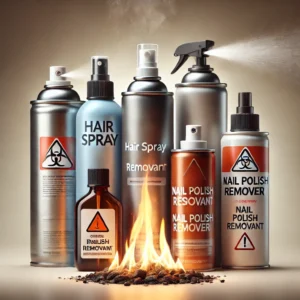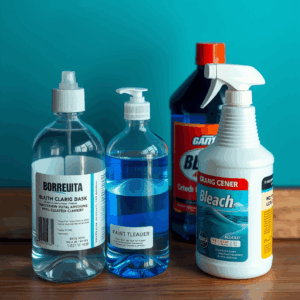A new warning highlighted in the Manchester Evening News revealed those ordinary household items that could dangerously start a fire. The report cited that over 30,000 fire incidents in the UK occur annually due to improperly disposed lithium batteries, unused aerosol cans, or cleaning agents. These flamable things often go unnoticed until they cause significant damage, illustrating the importance of fire prevention in households.
Identifying Flamable Things in Your Home
Flammable items are often part of everyday life, but their presence can create unexpected and dangerous scenarios if not managed properly. Here are some common household items that homeowners and potential buyers of fire-damaged properties should watch out for:
1. Lithium Batteries
Lithium-ion batteries are the power source for many modern devices such as smartphones, laptops, and children’s toys. The extreme convenience of lithium means that these batteries can overheat and catch fire upon damage. Lithium batteries burning can yield oxygen, a unique hazard making it difficult to extinguish the fire.
For sellers of fire-damaged homes, ensuring all fragments of old or damaged batteries have been properly discarded is a vital step. Potential buyers should also check if there are any remaining devices or appliances that contain these potentially hazardous batteries.
2. Aerosol Cans
Aerosol cans are common household items, be they hairspray, deodorant, or even air fresheners. Yet, they use flammable propellants, and at high temperatures or direct flame exposure, they instantly turn into firebombs. Improper storage near a heat source is the usual cause of household fires.
If you’re putting a fire-damaged home up for sale, removing any remaining aerosol products and their accompanying risks can help reassure buyers. For prospective homeowners considering these properties, it is very important to inspect all the storage areas, such as cupboards and garages, where old aerosol cans might be hidden.

3. Cooking Oils and Grease
Many people think cooking oil is harmless, but it is a very flammable substance that can ignite when overheated. The dangers of spontaneous combustion of improperly discarded oily rags make it easy to understand why kitchen fires combine with fires caused by negligence to become one of the leading causes of fire damage to homes.
For maximizing the value and appeal of the damaged property in terms of safety, sellers should pay maximum attention to renovating kitchen areas and safe disposal of hazardous materials like oil. Buyers, on the other hand, should ask whether any kitchen-related fire incidents occurred and survey the renovated areas for upgrades with safety issues in mind.
4. Cleaning Supplies
Cleaning agents, such as alcohol, bleach, and paint thinner, are common flamable things tucked into household cabinets. While they’re vital for maintaining hygiene, accidental spills or improper storage can lead to dangerous chemical reactions.
Correctly storing or discarding the chemicals is a major safety concern when buying or selling. This emphasizes the secure storage of property and makes it more attractive to potential buyers.

How Sellers Can Reassure Buyers
When putting a fire-damaged home on the market, there are several ways sellers can address buyer concerns about flammable household items and overall property safety.
Full Disclosure of Fire Damage
Be upfront about any previous fires and the steps you took to mitigate risks moving forward. Detail repairs made to electrical systems, kitchens, or storage areas, which were commonly associated with flamable things contributing to the fire.
Showcase Safety Upgrades
Install smoke detectors, fire alarms, and extinguishers to show the diligence of such precautions. If inspections have been done in regards to hazardous materials, such as chemicals or electrical wiring, share the findings of those inspections with buyers to inspire confidence.
Declutter and Remove Hazards
Removing leftover chemicals, old appliances, or other potentially flammable substances before showing the property can eliminate any lingering risks. Highlighting this attention to detail can frame your house as a safer option.
Everyday household items, from lithium batteries and aerosol cans to grease and cleaning supplies, may seem unassuming but can become dangerous, flamable things under the right conditions. For those buying or selling fire-damaged homes, understanding and addressing these hazards is critical.
Safety upgrades are definitely attractive to buyers as they remove dangerous aspects of the property, although for the most part sellers will choose to focus on them. Buyers, on the other hand, must pay close attention to spotting any remaining hazards needing attention. Hence, once the hazard is treated, a fire-damaged house could once again transform into a safe, workable, and valuable habitat.
Previous